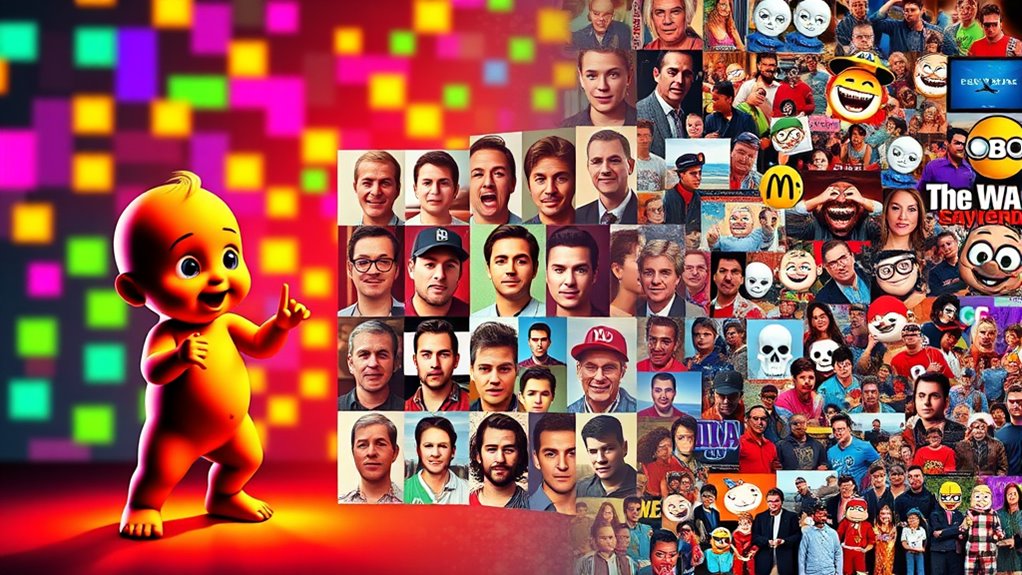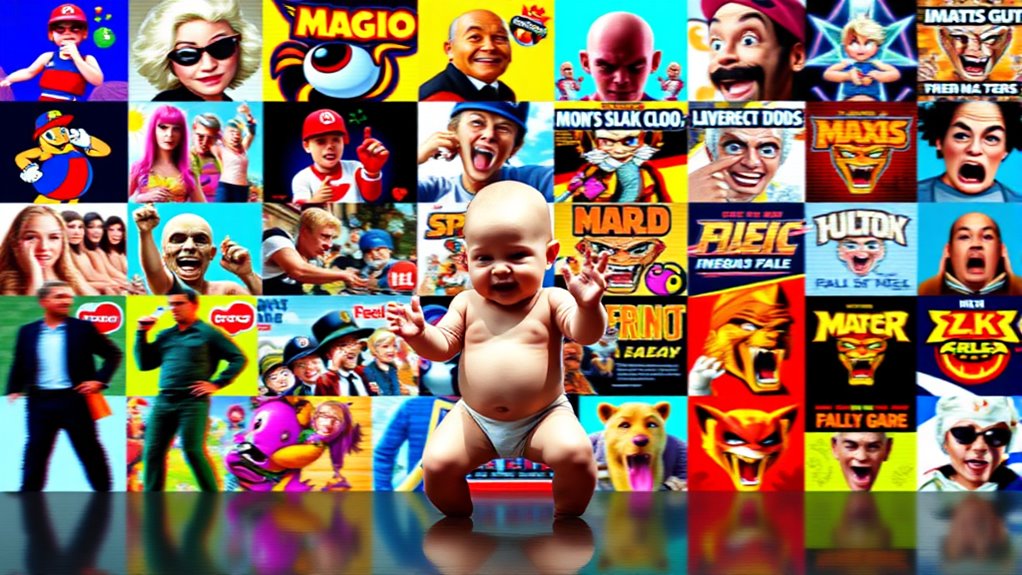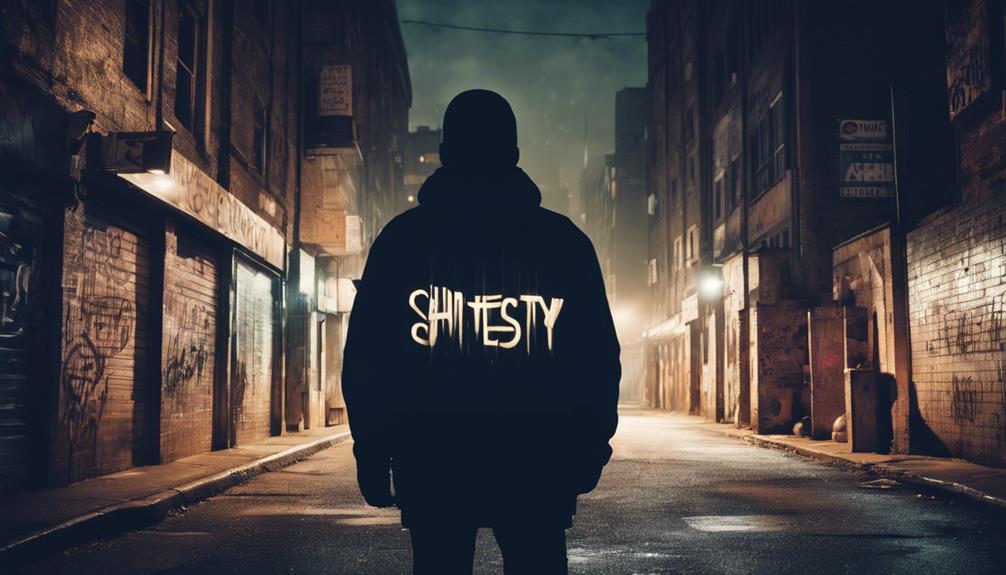You see how internet memes started as simple images like the Dancing Baby, spreading through early platforms and email chains. Over time, social media revolutionized meme culture, making remixing and sharing easier for everyone. Today, memes are more complex, with formats like deep-fried images that push visual boundaries. This evolution reflects changing online humor and societal trends. To understand how memes shape culture now, there’s much more to explore beyond this quick overview.
Key Takeaways
- Early memes like Dancing Baby and All Your Base spread virally through email, establishing basic digital meme culture.
- The rise of social media platforms enabled easy sharing, remixing, and cultural referencing of memes.
- Modern memes incorporate complex formats like deep-fried images, emphasizing humor through distortion and aesthetic absurdity.
- Memes evolved from simple images to layered, highly edited visuals reflecting internet subcultures and societal trends.
- Today, memes serve as vital tools for cultural commentary, shaping social conversations and digital art movements.

Internet memes have become a dynamic form of cultural expression, evolving rapidly as they spread across platforms and communities. When you think about the viral spread of memes, it’s clear how quickly an idea or joke can leap from one corner of the internet to another, sometimes within minutes. This rapid dissemination isn’t just about entertainment; it shapes social conversations, influences trends, and even impacts mainstream media. Memes have a unique ability to capture collective feelings, humor, or opinions in a way that’s accessible and easily shareable. Their cultural impact is profound, often reflecting or challenging societal norms, politics, and identity. As memes evolve, so does their significance—they’re no longer just funny images or videos but powerful tools for communication and cultural commentary.
In the early days, memes like the Dancing Baby or All Your Base were simple, often just a funny image or clip, but they ignited a wave of creativity that set the stage for what’s possible today. These initial memes spread virally through email chains and early forums, demonstrating how quickly content could go viral before social media platforms existed. Over time, the internet’s landscape shifted, and so did the memes. Platforms like MySpace, Facebook, Twitter, and Instagram became fertile grounds for meme culture, enabling users to remix, adapt, and share content with ease. This democratization of content creation amplified the viral spread, allowing even casual users to become meme creators. The cultural impact deepened as memes grew more complex, layered, and context-dependent, often referencing current events, pop culture, or inside jokes.
Today, memes have reached a new level of sophistication with formats like deep-fried images, which distort and exaggerate features to create a surreal or humorous effect. These memes can go viral for their absurdity or aesthetic, influencing internet humor and art. They also serve as a reflection of internet subcultures, capturing the zeitgeist of digital communities. The evolution from simple images to elaborate, heavily edited memes highlights how creators push boundaries and experiment with visual language. As memes continue to evolve, their power to shape cultural conversations remains strong, proving that they are not just fleeting jokes but integral parts of modern communication. The viral spread and cultural impact of memes show no signs of slowing down, making them an essential aspect of how we connect, express, and understand each other in the digital age. Additionally, understanding the digital communication tools that facilitate meme creation can help explain their rapid proliferation and cultural significance.
Frequently Asked Questions
How Do Memes Influence Internet Culture Globally?
Memes shape internet culture worldwide by spreading viral virality quickly. You often share and create memes that reflect current trends and humor, influencing online conversations. They foster a sense of community and identity among users. However, meme moderation is essential to prevent harmful content from spreading. Overall, memes empower people to express ideas creatively, making the digital space more engaging and culturally diverse.
What Are the Psychological Effects of Meme Consumption?
Memes are like mirrors reflecting your feelings and beliefs, shaping your identity online. When you consume memes regularly, you might experience mood boosts or fleeting laughter, but meme addiction effects can also lead to reduced attention spans and social withdrawal. You may find yourself craving the humor or relatability, which influences your mental health over time. Be mindful of how memes impact your perception and emotional well-being daily.
How Do Meme Trends Spread Across Different Platforms?
You see meme trends spread across platforms through viral challenges and meme remixing. When a funny or relatable meme catches on, people share it widely, creating a viral challenge that motivates others to participate and remix it with their own spin. This cycle accelerates across social media, with users reposting, commenting, and creating variations, allowing memes to evolve and reach diverse audiences quickly and effectively across different platforms.
What Role Do Memes Play in Political Activism?
Memes play a powerful role in political activism by fueling civic engagement and shaping public opinion. You can use memes as tools in memetic warfare to spread messages quickly and creatively, making complex issues more accessible. They rally communities, challenge narratives, and amplify voices that might otherwise be overlooked. By sharing or creating memes, you actively participate in political discourse, influencing perceptions and encouraging others to engage civically.
How Are Memes Monetized in Digital Marketing?
You can monetize memes in digital marketing by boosting brand engagement and creating viral content that resonates with audiences. Brands often collaborate with influencers to share memes, increasing reach and authenticity. These collaborations help promote products subtly while entertaining viewers. By leveraging meme culture, you connect with consumers more effectively, turning meme popularity into revenue. This approach makes marketing campaigns more relatable, memorable, and shareable, ultimately driving sales and brand loyalty.
Conclusion
As you’ve seen, internet memes evolve faster than you can scroll. Today’s deep-fried images and viral challenges hint at what’s next—something even more surprising. Will the next meme redefine humor or spark a new online movement? Only time will tell. Stay tuned, because the story isn’t over yet. The digital world’s next big meme might be just around the corner, waiting to catch you off guard and change everything again.










